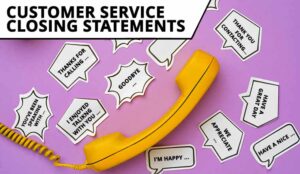Here are ten ways inbound agents can increase sales success.
1. Sell the benefits, not the features
Customers are no doubt interested in the full features of their purchase, so there is no reason to leave information out of your pitch. All product details should be on the table, but it’s the benefits that really motivate buyers to complete a purchase.
Marketing to consumers is all about creating an emotional relationship with the product. Air conditioning in the car means nothing – but keeping your children cool in the summer holidays is important.
Anyone can list features, but knowing how they will apply to a customer is a real skill.
2. Pair questions with statements

Whether performing sales or service, contact centre staff usually need to take a lot of information from customers.
Responding to a long list of questions puts the customer into autopilot and prevents them from engaging with the call. There is no emotional component to reciting personal details.
Instead, the approach should be conversational, with information being offered as much as requested. This is as simple as saying, “My name is Jack. Can I take your name, please?”
In a sales situation, a question could be phrased as “Our online account system means you can view your account at any time. Do you ever have difficulty getting information from your current supplier?”
An additional benefit is that the statements provide context for the questions you ask.
3. Be a professional seller, not a hard seller
The best sales staff are highly motivated and focused on closing every sale successfully. However, it is important to separate being driven from the tendency to sell aggressively.
Hard sellers are pushy and dictate terms to their customers. This might actually work sometimes, but it’s not going to leave the customer feeling too positive about their purchase.
The professional seller helps their customer to discover solutions through discussion. They develop an understanding of needs, and participate in matching a product to fit.
It’s the nature of most prospects to be slightly suspicious of what they are told by salespeople. That’s a good thing – it helps consumers to make smart choices – but it also means that sellers need to help customers makes decisions, rather than doing it for them.
4. Demonstrate expertise

There should never be a product-related question that a salesperson cannot answer. Expertise allows sellers to communicate the full package of benefits to buyers, but it also displays their enthusiasm for the product.
Sales agents should be knowledge sources, because these are the kinds of people the public will buy from. If you don’t know something about your product, that clearly indicates that it’s not so interesting. If the seller isn’t interested, why would the buyer be?
Customers are also more likely to listen to an agent who shows enthusiasm. While they might interrupt someone who is clearly reading from a script, they will usually hear out someone who speaks with passion.
“If you sound flat and uninterested, your customer will pick up on the negative vibe. Be upbeat but not over the top, and make sure your customer can feel the words you say,” said Steve Ashcroft, Business and Life Coach Specialist at Steve Ash Consultants.
5. Relationship building is key
To believe in the product, a customer first has to believe in the salesperson. Asking questions about their life will not only help sales staff to learn customer needs, it will establish the seller’s legitimacy.
Here’s an interesting scenario for sales teams in training: It’s lunchtime, and you’re hungry – would you buy a sandwich from a stranger in the street?
Most people say no, because they’re not sure about the stranger. They picture an odd individual with a questionable sandwich. But what if the stranger turns out to be an employee at a nice-looking sandwich stand? With this additional information, most people’s answer changes.
The point is, when a customer calls a contact centre, they can’t see who they’re talking to.
It’s important to establish your credentials.
6. Identify and challenge obstacles

Even the best salesperson will encounter rejections from time to time. What separates the ‘very best’ from the ‘next best’ is knowing what prevented the sale and how to change that next time.
The chance to learn is one good reason to understand why a customer says no. But the best reason is that it’s only by understanding the obstacle that you can start to overcome it.
A customer may say that they don’t want the hassle of switching providers – a clear message that you need to communicate how easy it will be.
They may say that they don’t think they can afford a premium service, meaning you need to find out if it might actually save them money in the long term.
7. Get customers visualising purchases
When a customer pictures how a purchase is going to benefit their day-to-day life, most of the heavy lifting of making a sale is done. Establishing that desire is a major part of a salesperson’s role, and there are several ways to get it done.
One of the most direct approaches is to ask the customer to describe the impact themselves. After all, nobody is more aware of their circumstances than they are.
Naturally, asking a customer to talk about their life should only be approached after a good rapport has been established. If you sense hesitance, offer up some information of your own; what you would like to do with the same product, or what you personally use.
“When a customer visualises what they’ll do with the product, they sell it to themselves,” said Paula Wingate, Business Coach Trainer at Action Coach.
8. Ask for the sale

This is a straightforward piece of advice, but also a very necessary one. Sales staff often go through the process of discovering customer needs and establishing a solution but not actively pursuing the sale.
Modern sales techniques have come a long way from the idea of ‘just getting to yes’. Behaviours that were once standard practice are now called into question, and sellers have come to realise that closing sales is a collaboration, not a trap.
However, this can lead to salespeople feeling unsure about when it is appropriate to push for a decision. It’s not bad practice to close – when the customer gives a firm no, and their objections are solid, then it’s time to leave it alone. Until then, ask if not now, then when?
9. Matching and mirroring
In our daily lives, everybody mirrors the characteristics of the people they meet. Our accents, the tone of our voices, and even the way we laugh, are all subject to subtle shifts.
This helps people to connect, and is very useful in sales environments because prospects are less interested in what is said than the connections they foster.
However, the need for perfect diction and a professional tone sometimes leads sales staff to avoid mirroring. This can make them seem aloof, and removes one of the most useful tools in their kit.
Reflecting a customer’s tone and language choices back to them is not a con; it’s a natural part of effective communication.
10. Open questions invite conversation

This is a staple of customer service calls, but it sometimes gets overlooked in sales. Salespeople often seem to believe that controlling a call means doing all the talking, but this couldn’t be further from the truth.
In fact, closed questions allow customers to simply say ‘no’ to whatever you’re offering, which is the default position for many of them.
Open questions enable customers to describe and elaborate, which presents key insights into how to appeal to them. When customers think aloud, they reveal their needs and are actually participating in the sale.
With thanks to:
- Paula Wingate – Founder of Influential Minds
- Steve Ashcroft – Business and Life Coach Specialist at Steve Ash Consultants
Click here for our Top Tips for Selling Over the Phone
Author: Megan Jones
Published On: 23rd Nov 2016 - Last modified: 22nd Mar 2017
Read more about - Skills, CX, Handling Customers, Rapport, Telesales





















